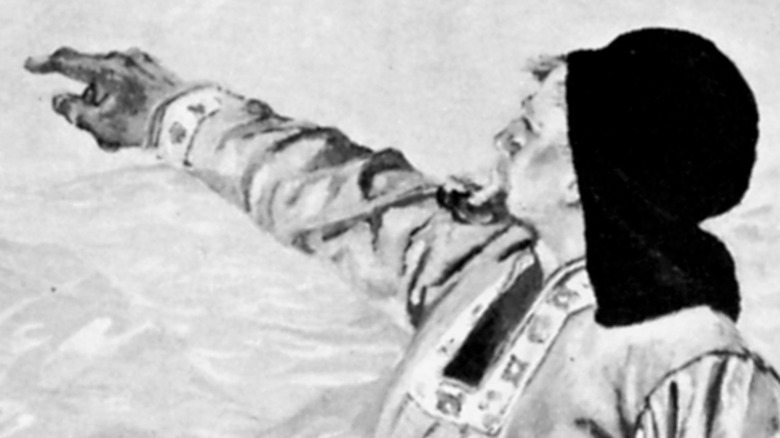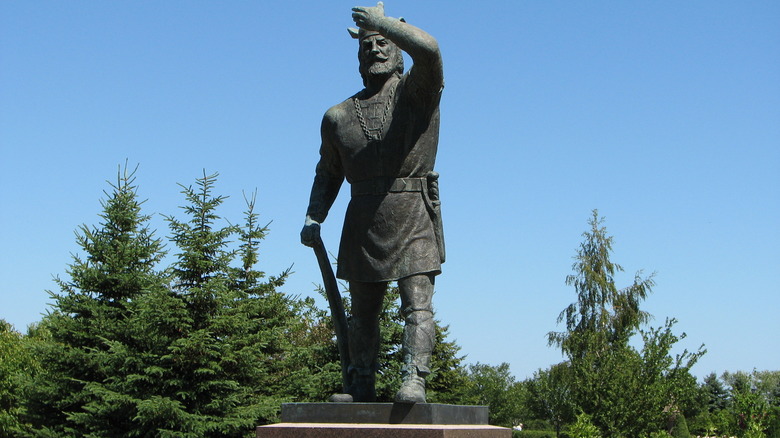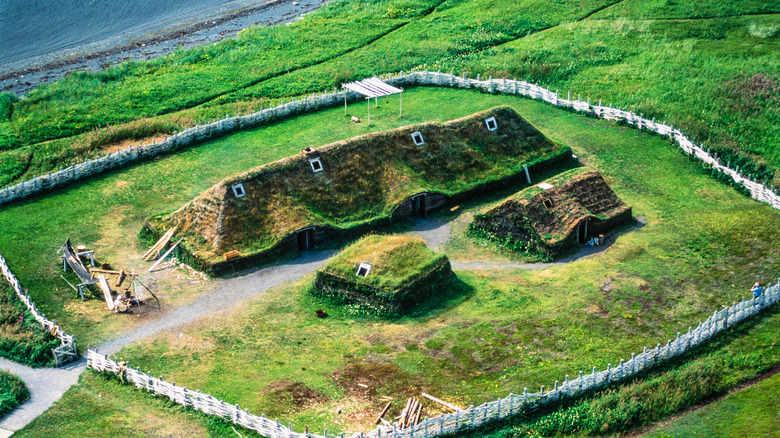The Truth About Leif Erikson's Famed Journey To Vinland
You could say exploration was in Leif Erikson's blood. He was the second of three sons of Erik the Red, a feisty Viking who created the first European settlement on Greenland somewhere around 980 CE after Iceland banished him from the country, according to Biography.
Erik's nickname resulted from his volatile temperament and red hair and beard. His own father, Thorvald Asvaldsson, shared that penchant for violence and needed to leave Norway after killing a man. Erik settled in Iceland, married Thjodhild Jörundsdóttir, and thrived until his servants caused an accidental landslide that destroyed his neighbor's home. That triggered a bout of bloodlust with a kinsman of the victim, Eyiolf the Foul, who murdered Erik's servants. In return, the bearded Viking took the lives of Eyiolf and another member of the clan. That caused his exile from Haukadale, or Eriksstead, as Erik the Red called it, and he moved further north to the island of Oxney. He later killed two others in a property squabble and that ousted him from Iceland for three years (Biography).
What Leif's (also known by Eiriksson, Erickson, or just "Leif the Lucky") early days were like are unknown, but many believe he spent his youth in Greenland, after being born in Iceland about 970-980 CE, according to the World History Encyclopedia. "The Saga of Erik the Red," a 13th century Icelandic manuscript, describes a journey from Greenland to Norway that Leif took about 1000 CE (via History) that set him on course for his Vinland discovery.
An accidental landing
Once in Norway, Erikson visited with King Olaf I Tryggvason, who converted him to Christianity, and commissioned him to convert other settlers in Greenland (via History). Some say that Erikson lost his way as he traveled home and spent several months in North America, exploring a section the Norse dubbed Vinland, or "Wine Land." It is believed the area extended from Newfoundland to the Gulf of St. Lawrence, and maybe even extended to Prince Edward Island and New Brunswick, according to The World History Encyclopedia. Sources like the New World Encyclopedia believe the areas he first visited were Helluland (the "flatstone land") and perhaps Baffin Island, before he landed on Markland, now known as Labrador (the "wood land").
The Viking and his crew enjoyed all the wonder Vineland offered, from timber to fur-trapping to the grapes it was named in honor of, according to Encyclopedia Britannica. Others believe he tried to find the land after hearing stories about the place from an Icelandic trader. He stayed through the winter, creating temporary shelters, and then sailed back to his homeland. Although he never came back, he is thought to be the first European to visit North America, some four centuries prior to Christopher Columbus' ballyhooed arrival in 1492.
Leif's brother, Thorvald, also had the family wanderlust and visited Vinland himself, intending to start a Viking settlement there. The Native Americans, who lived there first, though, had other plans and fighting broke out that ultimately killed Thorvald (via History).
Unanswered questions about Erikson's discovery
Whether or not Erikson "discovered" Vinland is often disputed. Much of his story came from two ancient texts, "The Saga of the Greenlanders" and "Erik the Red's Saga," which were written more than 200 years after the voyage, according to the World History Encyclopedia, and included no accounts from anyone who actually traveled with Erikson. However, the books share mostly similar stories, which enhances their veracity.
Time magazine explains that much of the evidence that exists about Erikson's time in Vinland is probably fraudulent. That includes an alleged 1440 "Vinland Map," a Norse penny, and the Kensington Stone, a tablet that supposedly uses runes to tell the story of Erikson's voyage to North America. Archaeologist did uncover Norse ruins at L'Anse aux Meadows in Newfoundland during a 1960 dig by a married couple, Anne Stine and Heige Ingstad, that indicate at least some Vikings spent time there (photo above).
Erikson eventually became chief of Greenland when his father died in 1000 CE. He continued his missionary work and allegedly converted his mother to Christianity. She, in turn, started the first Christian church in the country (via New World Encyclopedia).
The Viking's accomplishments, as well as those of others of Nordic descent, are showcased each year on Leif Erikson Day on October 9 in the United States. The Norseman received his special day on September 2, 1964, after the U.S. Congress passed Resolution 88-566 that authorized President Lyndon B. Johnson to proclaim the date Leif Erikson Day (via National Day Calendar).


